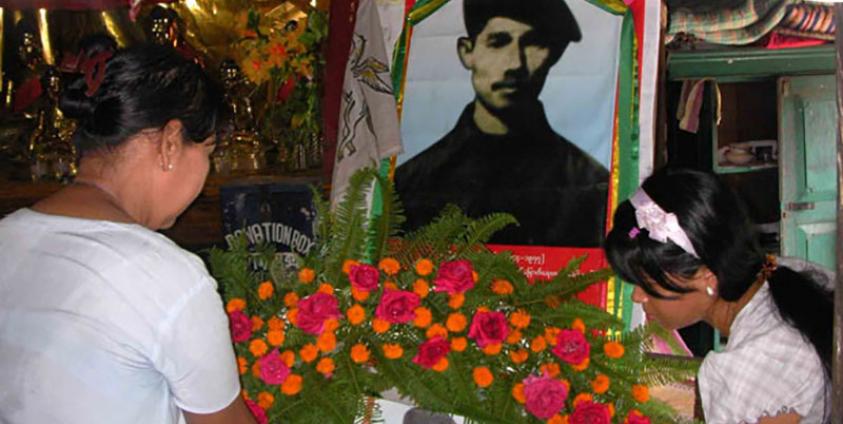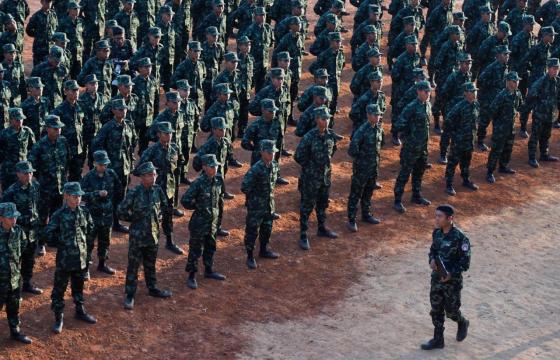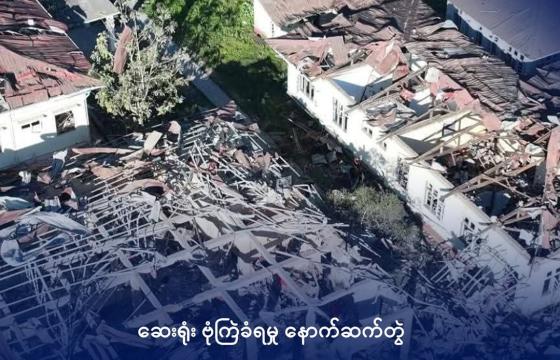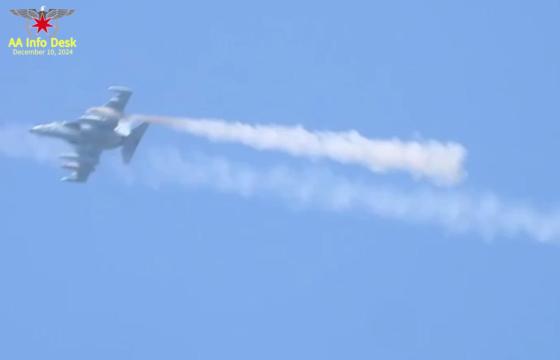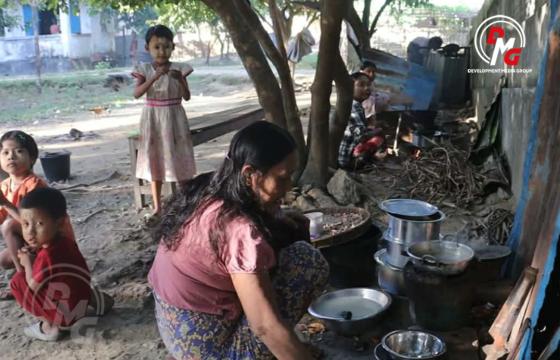Rainy days often contribute to sadness. For veteran Arakanese revolutionaries, they can’t help but remember one person in particular each year on June 4, around the time of the monsoon rains’ annual onset.
“He had the spirit of a martyr. He was burning with the desire to rescue Arakanese people from many years of hardships. So, he engaged in revolution at the risk of his life,” veteran Arakanese revolutionary and chairman of the Arakan Liberation Party (ALP) Khaing Ray Khaing said of his former comrade Khaing Moe Lun, founder of the affiliated Arakan Liberation Army (ALA).
Khaing Moe Lun died on June 4, 1977, some 45 years ago, making the ultimate sacrifice for the cause of an independent Arakan State.
Arakan State lost its sovereignty and fell under Bamar rule when the Arakanese Kingdom was invaded by the Bamar King Bodawpaya in 1784. After Myanmar gained independence from the British in 1948, the Arakanese people started their own revolt against the centralised control of the Bamar-dominated government.
Among the revolutionaries who rose in rebellion against the central government after independence were Thakhin Soe and Thakin Than Tun of the Communist Party of Burma, Buddhist monk Sayadaw U Seinda, U Tun Shwe Maung, Saya San Kyaw Tun (AIA) [Arakan Independence Army], U Kyaw Zan Shue and Major Maung Han of the Arakan Communist Party.
Khaing Moe Lun was one of the most prominent Arakanese revolutionary leaders who dreamed of establishing an independent Arakan nation.
Who Was Khaing Moe Lun?
He was born on February 8, 1934, to U Maung Phyu Thee and Daw Hla Nyunt Oo in Awada village, Rathedaung Township, and his birth name was Tun Sein Hla. He was the second of three sons and also had three sisters.
He attended primary school in his village and also made religious study at monasteries in Ponnagyun and Rathedaung townships. He then went to Yangon, where he stayed at the monastery of a Buddhist monk who was a Rathedaung native.
The country was then under the rule of the Burma Socialist Programme Party (BSPP) led by dictator General Ne Win. Khaing Moe Lun worked at a public property protection group before joining the Navy “on a mission.”
He got involved in politics in 1965 under the leadership of his childhood teachers in Yangon, Khaing Soe Naing and Khaing Ba Kyaw, according to ALP leaders.
Under his birth name Tun Sein Hla, Khaing Moe Lun founded the ALP at the Theikpa Mizzu Monastery in Yangon’s Kamayut Township on April 9, 1967, as an underground revolutionary group.
The 11-member Central Executive Committee (CEC) was composed of patriotic young Arakanese men, monks, workers and political enthusiasts. The ALP was then chaired by Khaing Pyi Thein, with Khaing Soe Naing serving as general secretary and Khaing Moe Lun acting as the in-charge of military affairs.
Khaing Moe Lun and some CEC members joined the Burmese Navy and were assigned to a naval base in Thanlyin, on the outskirts of Yangon. They had an undercover mission to execute — to learn military skills and strategies, collect military intelligence about the Burmese armed forces, and obtain weapons and ammunition.
“He joined the Navy to learn military organisational structure, skills and gain military experiences for the Arakanese revolution,” said Khaing Ye Khaing.
Khaing Moe Lun and his team had planned to steal weapons from the Wah Bo base under Light Infantry Battalion No. 20 in Arakan State’s Sittwe in November 1968. They had planned to travel to Mrauk-U to establish a base and from there launch their armed struggle. However, a member called Ray Htun betrayed his comrades two hours before the operation was to commence. Several ALP leaders were subsequently arrested.
“We had our men at the warehouse that stored weapons and ammunition. We planned to take arms from there,” explained Khaing Soe Naing Aung, who fought alongside Khaing Moe Lun for many years in the Arakan revolution.
Nine leaders who were serving at the naval base in Thanlyin, including Khaing Moe Lun and Khaing Ray Khaing, were detained and jailed, marking a period of hiatus for their armed revolution. In 1972, they were released in a general amnesty by the BSPP government. Khaing Moe Lun then returned to his native village and worked as a merchant, according to family members.
Revolutionary Mindset
“He returned with three boxes of books after he was released from prison. There were many political books,” said U Tun Oo Phyu, a son of Khaing Moe Lun’s elder sister. The 75-year-old still lives in Awada village and was Khaing Moe Lun’s playmate when the two were young.
“What I remember is he always fought when we were young. He never admitted defeat. He was a hard worker and had a strong sense of justice,” said U Tun Oo Phyu.
Khaing Moe Lun married a woman from nearby Tun Yawai village, but they had no children. She married again when Khaing Moe Lun left the village to resume his unfinished mission in life.
In 1973, Khaing Moe Lun travelled to Karen National Union (KNU) territory and contacted Khaing Pyi Thein looking to reboot the armed struggle. Another leader, Khaing Soe Naing Aung, came from the mainland to join Khaing Moe Lun at the KNU’s Wan Kha camp.
“There were many hardships. We did various jobs for the operation of our group. I made charcoal. Khaing Moe Lun had medical knowledge and worked as a medic,” Khaing Soe Naing Aung remembered of their struggles on the road to revolution.
KNU leader General Saw Bo Mya agreed to assist the Arakan revolution. On June 1, 1974, Khaing Moe Lun founded the Arakan Liberation Army (ALA), for which he acted as the military chief and chairman. Other leaders were Khaing Ray Khaing, who served as the vice chairman, and Khaing Soe Naing Aung.
The KNU provided the ALA with a battalion’s worth of weapons and ammunition. Khaing Moe Lun and his comrades fought alongside the KNU for three years, broadening their military and combat experiences.
Khaing Moe Lun was bookish, and he learnt and drew inspiration from the biographies of famous revolutionaries like the Argentinian Che Guevara, Cuban brothers Fidel and Raul Castro, Vietnam’s Ho Chi Minh and India’s Gandhi, according to his former comrades.
With political and military experiences, the ALA grew into a fully armed 120-troop army by 1976, thanks in large part to the courage, leadership, and combat capabilities of Khaing Moe Lun.
The Journey Home
The ALA, led by Khaing Moe Lun, decided to base itself in Arakan State as soon as they had mobilised enough strength for the journey west. In the last week of June 1976, more than 120 ALA members, headed by Khaing Moe Lun, Khaing Ba Kyaw, Khaing Ray Khaing and Khaing Ni Lun, began their 2,000-mile journey to Arakan State from Karen State.
Khaing Soe Naing Aung said the troops arrived in Chin State in February 1977 after a journey that crossed much forbidding terrain including the Naga Hills, and the states of Karen, Karenni, Shan and Kachin.
Along with the ALA troops were Major William and 13 other ethnic Chin who had deserted the Myanmar Navy to establish a Chin revolutionary armed force. This made it easier for Khaing Moe Lun and his comrades to buy food in the local language when they first arrived in Chin State. But after the death of Major William, the standing of Khaing Moe Lun and his troops in Chin State became more tenuous, and the Myanmar military learned of their presence and intentions through local sources.
As a result, more than 70 clashes of varying size and intensity took place between the Khaing Moe Lun-led troops and the Myanmar military in the Chin Hills. The BSPP brought in more than 6,000 troops to crush Khaing Moe Lun and his troops in an operation dubbed “Mya Yadanar”.
As the fighting dragged on, the Arakanese comrades fell into disarray due to imbalances in manpower, lack of knowledge of the local terrain, and the dwindling of ammunition and food.
Khaing Moe Lun and his troops eventually found themselves cornered by the military in Chin State’s Tongzan. He refused to surrender though, taking his own life rather than be taken captive.
“He, along with four other commanders and two medical officers, broke through the enemy and attempted to cross Tongzan Bridge. The Myanmar military repeatedly barricaded the cable-stayed bridge and ordered them to surrender. He [Khaing Moe Lun] committed suicide without surrendering,” Khaing Soe Naing Aung recounted of the last day of Khaing Moe Lun.
Khaing Moe Lun led the Arakanese armed revolution from 1965 until June 4, 1977; he was 43 years old when he was martyred by the Myanmar military.
Khaing Moe Lun held five revolutionary commitments:
(1) To establish the Arakan Army for the independence of Arakan
(2) To join forces with the oppressed revolutionary forces for the liberation of Arakan
(3) For the independence of Arakan, there is no choice but to take up arms
(4) The independence of Arakan is in the hands of Arakan national unity
(5) Kneeling before an enemy is an unforgivable crime for an oppressed people
Fifty-two people were arrested by the Myanmar military that day, all of whom were detained by Light Infantry Battalion No. 89, based in Kalemyo, Sagaing Region, for questioning.
Seven people, including the current ALP chairman Khaing Ray Khaing, were sentenced to death after a military tribunal charged them with high treason under Section 122(1) of the Penal Code. The other 45 were sentenced to life imprisonment or lengthy prison terms. Khaing Ray Khaing, Khaing Ni Lun and Khaing Myo Min were eventually released in an amnesty under the dictator U Ne Win.
In death, Khaing Moe Lun was hailed as a martyr by leaders and colleagues of the Arakanese national liberation movement. His contribution to that cause — and ultimate sacrifice — is still remembered to this day, as evidenced by the multiple commemorations that were held on June 4 this year.
“He was an Arakanese hero who fulfilled his political duty, driven by a desire for liberation from Burmese rule,” said Khaing Mra Wah, a former National United Party of Arakan/Arakan Army (NUPA/AA) chairman and veteran rebel leader. “He was also a rare leader who committed suicide rather than kneeling to an enemy.”


